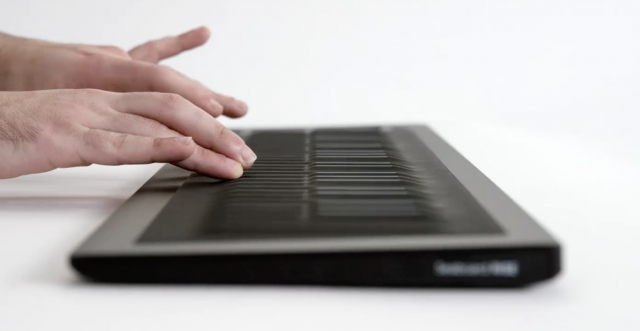At the Winter NAMM Show, expressive controller manufacturer Roli featured a variety of artists at its booth, showcasing its RISE controllers with virtuosic musical performances.
In this video, keyboardist and synth designer Jordan Rudess performs a classically-inspired composition on the Roli Seaboard Rise 49 controller.

The Seaboard RISE 49 is a four-octave model of its Seaboard RISE controller, The RISE controllers are designed to capture per-finger expression and to support the proposed Multidimensional Polyphonic Expression (MPE) standard for communicating expressive performance information.
Pricing and Availability
Roli’s Rise 49 controller retails for $1199 (£949, €1299) and is currently available for preorder on the Roli website. The controller is expected to ship in late February 2016, and be available via Roli’s network of retailers in North America and Europe in the first quarter of 2016.

What VST is he playing? Pretty good sound
Pretty sure that this is the Equator synth, also by Roli (included with the Seaboard)
real players like me only use full size weighted piano keys with aftertouch not this junk. worse than mini keys and its not even analog
Yeah, well, real players like me only use copper timpanis with horse-stretched heads, none of your keyboard junk. Worse than bongos, and not even acoustic.
Now, if you think I sound stupid, then maybe you should read back over your post. They’re different instruments. If you don’t like it, don’t get one, and don’t learn how to play it.
Whoosh.
Drat. You think? It’s hard to decern sarcasm from genuine stupidity on the internet sometimes.
this demo sounds like a violin, i heard one sounding like an electric guitar. both were pretty good – but isn’t there anything new, innovative, never heard before in the roli? MPE has so many opportunities…
seems to all be monophonic aswell. almost as if it could be recreated with fancy modwheel mapping. onlything ive really seen/heard is the continous pitch control, which again, if glide/slide time is mapped to a wheel, and filter cutoff to an expression pedal (or vice versa) is not too wildly out of reach with a ‘regular’ controller.
as mentioned, for recreating a violin, not too shabby, but still sounds awkward. doesnt seem to take advantage of what MPE is claiming to unlock, and i still havent seen a good example of MPE’s potential.
Admin: Personal attack deleted. Keep comments on topic and constructive.
When ever I listen a controller or synth trying to imitate an instrument like a violin, it is and always will be a turn off for me. On the other hand I will always be interested to see and listen the use of new controllers, synths and technologies to create something new and unique. This video unfortunately is not the case.
Based on the videos I’ve seen on the net, I get the impression that the Seaboard Grand is a much more playable instrument. Even the best keyboard players seem to struggle with the Seaboard Rise. Or is it just a coincidence?
Did you watch the same video? Rudess plays his ass off and the emulative instrument is pretty amazing.
IMHO, the solo doesn’t sound natural, it sounds forced. That’s what I meant with struggling. But it probably has something to do with the patch as well. Also, emulating a violin and violin playing is truly difficult. But I didn’t only refer to this video, also other Rise demos I’ve seen. It sounds like everyone is slightly struggling with controlling the pitch. Perhaps it’s just me.
I’ve played them both, and the updated surface used on the Rise instruments is (YMMV, obviously) significantly easier to play than on the Grand, at least in the brief time I’ve spent with them. The older surface was harder to glide smoothly on than the new material, whatever it it’s made of.
Thanks! What about the pitch? I get the feeling from the videos I’ve seen that it seems harder to control pitch on the Rise than the Grand? But I haven’t seen any head-to-head comparisons, so I can imagine it depends a lot on who is playing and what is being played.
Well, a bit difficult to tell in their booth at the show. In either case, if you don’t do anything deliberate to glide, they seem to stay locked to the pitch you hit (and to glide smoothly you need to shift your fingers up to the strips above/below the key waves.) For that kind of slippery playing based on brief NAMM booth tests, I found the Linnstrument’s surface to be easier to slide around on. In reality I expect to need to live with an instrument for a while to figure out its idiosyncrasies.
I don’t see any struggling in this video, and I didn’t see any when I was in the audience when he played this.
No, you don’t see any struggling, but listen to it without the video. The solo doesn’t sound natural, it sounds forced. That’s what I meant with struggling. Still, probably one of the better performances I’ve heard with the Rise.
yes, a face-melting experience …..as always with JR…….even on still pictures…..
Decent Demo. Most of these alternate controllers end up being lame in practice but this one at least seems reasonable. I usually can’t stand the playing of mr rudess but at least here he leaves a little air and there’s some dynamics. On the other hand if you want a violin get a violinist not someone trying to play one on a roli. Not yet convinced these alternate controllers result in anything musical (anyone see that touché thing… They spent $500k on marketing and then that same demo we keep seeing over and over again is like so what!)
Jordan respect!
I’m not a fan of certain elements but its great to see someone who is talented, but more so passionate about What he does , and hats off for spreading the word of synthesis and also alternative music technologies !